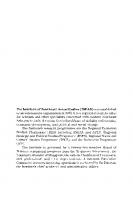Growth Determinants in East and Southeast Asian Economies [1 ed.] 9783428472659, 9783428072651
Already in the 1960s the four $.little dragons$- Hong Kong, Singapore, South Korea and Taiwan started their industrializ
120 82 32MB
English Pages 282 Year 1991
Recommend Papers
![Growth Determinants in East and Southeast Asian Economies [1 ed.]
9783428472659, 9783428072651](https://ebin.pub/img/200x200/growth-determinants-in-east-and-southeast-asian-economies-1nbsped-9783428472659-9783428072651.jpg)
- Author / Uploaded
- Koppers
- Simon; Dingens
- Susanne; Klaas
- Alberto; Wermuth
- Hans-Erich
File loading please wait...
Citation preview
KOPPERS I DINGENS I KLAAS I WERMUTH (Eds.)
Growth Determinants in East and Southeast Asian Economies
Schriften zu internationalen Wirtschaftsfragen Band 12
Growth Determinants in East and Southeast Asian Economies
Edited by
Sirnon Koppers, Susanne Dingens, Alberto Klaas and Hans-Erich Wermuth
Duncker & Humblot · Berlin
Die Deutsche Bibliothek - CIP-Einheitsaufnahme
Growth determinants in East and Southeast Asian economies I
edo by Sirnon Koppers Berlin: Duncker und Humblot, 1991 (Schriften zu Internationalen Wirtschaftsfragen ; Bdo 12) ISBN 3-428-07265-0 NE: Koppers, Simon; GT 0
0
0-
Alle Rechte, auch die des auszugsweisen Nachdrucks, der fotomechanischen Wiedergabe und der Übersetzung, für sämtliche Beiträge vorbehalten © 1991 Duncker & Humb1ot GmbH, Berlin 41 Fotoprint: Wemer Hildebrand, Berlin 65 Printed in Germany ISSN 0720-6984 ISBN 3-428-07265-0
Laudation lt is one of the more pleasant obligations of a chairman to speak at the various birthday celebrations which are held for meritorious colleagues. And it is particularly enjoyable to pay tribute to Professor Dr. Klaus Erich Rohde whose 6oth birthday we celebrate today. His charming character, bis active engagement in teaching, his interesting scientific work, have won him many friends, disciples and followers. Klaus Erich Rohde was bom in Danzig in May 1931, however, he moved to Braunschweig at the early age of five and stayed there until bis Abitur in 1950. He then studied economics at the University of Bonn where he was awarded the degree of Diplom-Volkswirt in 1953. This is an incredibly short time for completing one's studies, in particular if compared to the present average length of time for an economics degree in Bonn, which is approximately 13 semesters! Moreover, Klaus Rohde achieved the best possible grade. In the years following, Rohde worked as scientific collaborator at the Institute of Economics in Bonn. In 1955 he obtained bis Dr. rer. pol., once again with the best possible grade (summa cum Iaude). By then his interest in economic research had become predominant. After two years of research in Spain and in developing countries in North Africa and in the Middle East he became an assistant professor at the Institute of Economic Policy, where he did postdoctoral research under Fritz W. Meyer. In 1966 he finished his habilitation tbesis on "Social Costs in Systems of Market Economies" and became a Dozent in Bonn. His interest in development economics can clearly be seen by bis cboice of tbe topic of tbe test Ieelure (Probevortrag) on "Problems of Economic Development - the Example of Libya" and tbe topic of bis inaugurallecture as Dozent (Antrittsvorlesung) on tbe "Organization of Oil-Exporting Countries." In 1969 Robde became full professor of economics at tbe University of Erlangen-Nümberg and in 1972 be accepted an offer of Bonn University wbere he became a professor and tbe director of tbe Training and Documentation Centre for Foreign Economic Systemsand Economic Cooperation, two positions wbicb be currently bolds. Professor Robde continues to lecture on Development Economics to economics students as weil as to students in otber faculties. He also teacbes graduate courses in tbe tbeory and politics of inter-
6
Laudation
national cooperation, banking and growth-strategies. In recent years be bas organized many seminars on topical problems of developing countries with special reference to the Soutbeast Asian countries. He likes to travel. Therefore, if he speaks about problems of development economics, he knows these problems from personal experience. Hence, Klaus Robde is one of tbose Professors who bring real life into the classroom and belp their students understand problems based on examples of economic practice. Bonn, June 1991
Prof. Dr. Dr. Dieter Bös Chairman, Department of Economics, University of Bonn
Foreword This book is dedicated to Prof Dr. Klaus E. Rohde wbo is the Head of the Training and Documentation Centre for Development Policy, Department of Economics, at tbe University of Bonn/Germany. One of bis most important fields of research over the past several years bas been the development of the East and Southeast Asian Economies and the reasons for their success, always keeping in mind the question of the transferability of tbese experiences to other developing nations. Already in the 1960s the four "little dragons" Hong Koog, Singapore, Soutb Korea and Taiwan started tbeir industrialization moving steadily upwards with increasing growth rates, some of them double-digit in tbe 1980s. Most significant for these results bas been their export-oriented growtb strategy capitalizing on low labour costs and opening them up to the world market with all its benefits and pressures. Until today they have attracted quite a Iot of foreign investors bringing technology and skills beside the pure capital. Thus, all four countries have reached a more sophisticated Ievel of production and partly even developed into service and financial centres. The four "little dragons" are the first-tier Asian NIEs (newly industrializing economies). Nonetheless the ASEAN (Association of South East Asian Nations) members Malaysia, Indonesia, Thailand and the Philippines are following their development path and are also successful. Today they attract a Iot of low-labour production as an outward processing base also for the neighbouring little dragons. Another important development in the East Asian Region is tbe open door policy and the reforms in PR China which are providing many new opportunities especially in the special economic zones. In addition, they open a tremendous new market as weil as an additional base of low-labour production. Recently, the development in North Korea also showed some interesting changes. Combining these developments with the already advanced Japan, the entire Asia-Pacific Region must be seen as an extremely dynamic area often also mentioned as the "Pacific Challenge". Thus it is of high interest to examine
8
Foreword
the determinants of growth behind this challenge, behind the economic success. In line with these reflections this book analyzes important factors such as development planning, foreign investment, deregulation, govemment intervention, human capital, finance and banking (service sector), technology transfer and promotion, trade (export promotion), agriculture and regional cooperation. For this purpose experts in Science and Economics report from their experiences sometimes on a morenational Ievel, sometimes more regional, sometimes giving an overview and sometimes being more specific. As a whole, however, the reader should get an impression of the determinants of the rapid and dynamic evolution of the East and Southeast Asian Region. Nevertheless, one should always keep in mind that these are mostly economic developments still leaving many other problems to be solved such as population growth and poverty as weil as environmental protection. But as another important factor one should not forget that also a Iot still has to be done conceming democratization. The developments show that with rising standards of living also the calls for more democracy often become louder as shown for example in South Korea and Taiwan. Because of the specific Asian dimension of the success, especially the Asian mentality a transfer of the growth strategy can only be possible to a very limited degree. But the Asian experiences can at least be helpful to the formulation of a country related development strategy showing up generally important growth factors. After these general remarks the contributors to this book want to wish Professor Rohde a happy 60th birthday. We hope to take part in many of his future outstanding contributions to the field of East and Southeast Asian Studies. We also hope all students of East and Southeast Asian affairs will further be able to participate in the diversity of bis experience, thus gaining a deeper insight into the actual problems and developments of the specific Asian countries. Finally we want to thank Sophia Twarog, Carita Zimmermann, James Adams, and John Ramsey for their correcting the articles and giving helpful hints and practical support. Special thanks are dedicated to Prof. Dr. Rudolf Lassahn and his staff for making his Iaser printer available to us thus simplifying the Iayout very much. Bonn, June 1991
The Editors
Contents Dean Spinanger From Sandlots to the Big League: Some Thoughts on Why East Asia Has Been Winning ......... ... .. ........................ ........................ ... ... ..... .......... ........ . .. ... .. ..
11
F. Stefan Winter and Sigrid Zirbel Intemationalization and Globalization in the 1990s . . . . . . . . . . . . . . . . . . . . . . . . . . . . . . . . . . . . . . . . . . .
29
Sirnon Koppers Development Planning in East and Southeast Asian Economies ...... ............ . .. .... ...
41
RolfJ. Langhammer Competing for Foreign Direct Investment: The Performance of East and Southeast Asian Countries in the 1980s . . . . . . . . . . . . . . . . . . . . . . . . . . . . . . . . . . . . . . . . . . . . . . . . . . . . . . . . . . . . . . . . . . . . . .
59
Amim Kraemer Industrial Estates in Malaysia - Targets Expressed in the National Development Plans and Their Implementation . . . . . . . . . . . . . . . . . . . . . . . . . . . . . . . . . . . . . . . . . . . . . . . . . . . . . . . . . . . . . . . . . . . . . . . . . .
77
Alberto Klaas and Sophia Twarog Deregulation in the Financial Sector in Indonesia 1983- 1990 .. .... . ...... .. ..... .. .. . .... ..
93
Alexander Baum Capital Market Development in Southeast Asia: Portfolio Investments in Ernerging Markeis .. ... ..... ................... ... ... ...... .................. ... .. .. ................... .... ... .. ..
115
Susanne Dingens Technology as a Growth Detenninant- The Special Case of Hong Kong .. . .. . ... . . .. ...
131
Bettina Muscheidt Aspects of ASEAN's Agriculture, lts Contribution to Growth, and Its Relationship to the European Community .... .. .... ... ...... .... ... ..... .... ...... .... ........ . .. .. ...... .... .... ..
159
Man.fred Pohl A Farewell to Isolationism? North Korea's New Strategies .. ........... ............. .. ... ..
171
Waller Schug Analysis ofthe Republic ofChina 's Foreign Trade and Foreign Trade Policy ...... ... .
187
Erhard Lauven China's Foreign Economic Relations: Prospects ofthe Year 2000 ... .... ... . .. ...... ..... .
203
Hans Christoph Rieger Basic Issues of ASEAN Economic Co-operation ... ... ... .. ........ .............. .. .. ... .... ..
217
Sigrun Caspary The Sea of Japan Region - Perspectives of a Regional Cooperation . . . . . . . . . . . . . . . . . . . . . . .
239
Henning von Boehmer and Rainer Emschermann European Integration: Threat or Promise to East and Southeast Asia? . . . . . . . . . . . . . . . . . . . .
255
Contributors ............... ..... .. ... ... .. .. ... ....... ........... .. . ... ... ..... ... .. ...... .... .. . ... .. .....
277
From Sandlots to the Big League: Some Thoughts on Why East Asia Has Been Winning Dean Spinanger
I. Introduttion and Overview The advent of PACRIM Asia as a major player in today's big league economic world is nothing short of being diametrically opposed to accepted knowledge some mere 25 years ago. Let it be remernbered that back then a dismal futurebad been prophesized for this part of the world, with Myrdal's three volume Asian Drama providing the seemingly in-depth scientific underpinnings. In this tome, the following statements - not taken out of context - can be found: -
"Asia is a region poorly endowed with resources ...
-
It is commonly recognized that expansion of export outlets played a crucial role in the early period of development in all the now highly developed Western countries ...
-
Asia was not unaffected by this movement, ... (but) the initial spurts in production for export did not trigger a cumulative process of development in other sectors ...
-In any event, the epoch of rapidly growing export markets has ended ... -
Generally speaking, the Asian countries have in recent decades seen the demand for their exports shrink relative to the development of world trade ... The outlook for their export eamings is not bright. .. "1
While Myrdal was addressing South Asia as weil as the PACRIM region, there can be little doubt that he and many other economists saw problems rather than the potential and underestimated the role which undistorted prices play in signaling where investment opportunities are changing. It is the 1 Myrdal, Asian Drama, pp. 676 ff.
12
Dean Spinanger
purpose of this paper to briefly point to some factors which have contributed to this success. This will be done either by putting forth some newer thoughts and by shedding a different light on already known reasons.
ll. Making It to the Big League: the Essentials The economic success of the PACRIM countries has led to extensive research into the "why and how" of their growth paths. The interest is not just academic curiousity, but rather aimed at revealing what lessons can be learned for other countries in the process of trying to "shape up" their economies. This not being the place for an in-depth review of the literature,2 it seems appropriate to draw on the conclusions of a concise tour de horizon article on the P ACRIM success story by Riedel.3 There it is noted in concluding that while the policy of getting the prices right is not the whole story, getting prices wrong often is. "That is as true for democratic as it is for authoritarian countries, and as true for countries without as for those with a Confucian heritage. The policy lessons that derive from the experiences of the East Asian countries are simple and clear-cut, and for that reason are all too readily ignored or dismissed." In tuming specifically to the PACRIM countries in this connection in order to try to gather evidence beyond what Riedel and other authors have collected or put forth, it can be established that hard evidence on the extent and size of distortions in relative prices is difficult to come by. Aside from the often quoted study of Krueger4 there are no studies which offer such evidence on a comparable cross-country basis. As can be seen in Table 1 distortions in the two PACRIM countries listed are definitely lower than elsewhere. Yet more important is the evidence on the size of the distortions in relative prices this in itself tends to underline Riedel's contention that when prices are not "gotten right" they can indeed induce economic havoc. In the fmal colurnn, growth rates of real exports have been added to show that there is a strong negative correlation with relative price distortions. Even if hard econometric evidence cannot be drawn, there is, however, an interesting albeit pedestrian attempt to link distortions across factor/product rnarkets in DCs with selected economic performance indicators 2 Readersare referred to 'Asia-Pacific Economic Literature' (published by the National Centre for Development Studies at the Australian National University) for articles, comprehensive listings and reviews of the relevant Iiterature. 3 Riede/, Economic Development, p. 38. 4 Krueger, Trade and Employment.
1973 1968 1966-68 1973 1971 1961-64 1969 1972
Argentina Brazil Chile Hong Kong lvory Coast Pakistan South Korea Tunisia
15 27 n.a. 0 23 0 0 20
8 0 37 0 0 38 0 30
Trade Regime 9 4 n.a. 0 3b 53 8 6
Credit Rationing n.a. n.a. n.a. 0 12b 10 2 n.a.
Other
Percentage Reduction in Ca[!ital Costs Owing to
17 4 n.a. 0 15 76 10 36
Total
Source: Krueger, Trade and Employment, Table 7 .1.
Note: No quantitative estimates are available for Colombia, Indonesia, Thailand, or Uruguay.
a Calculated from World Bank, World Development Report 1989. b Estimates based on differentials given in Monson, Trade Strategies, Table 6.15.
Period
Country
Percentage Increase in Labor Costs
87
11
38 31 n.a. 0 45 316
5.1 10.0 8.1 10.1 6.4 0.4 22.9 7.4
Percentage Growth Rate ofReal Increase in WageiRental Exports Ratio 1970-80a
Table 1 Percentage Distortions in Labor and Capital Costs from Various Sources
.6.
~
t:
~
"= ~ = 2.
~
:I:
~.
~
.> .,.
~
'









